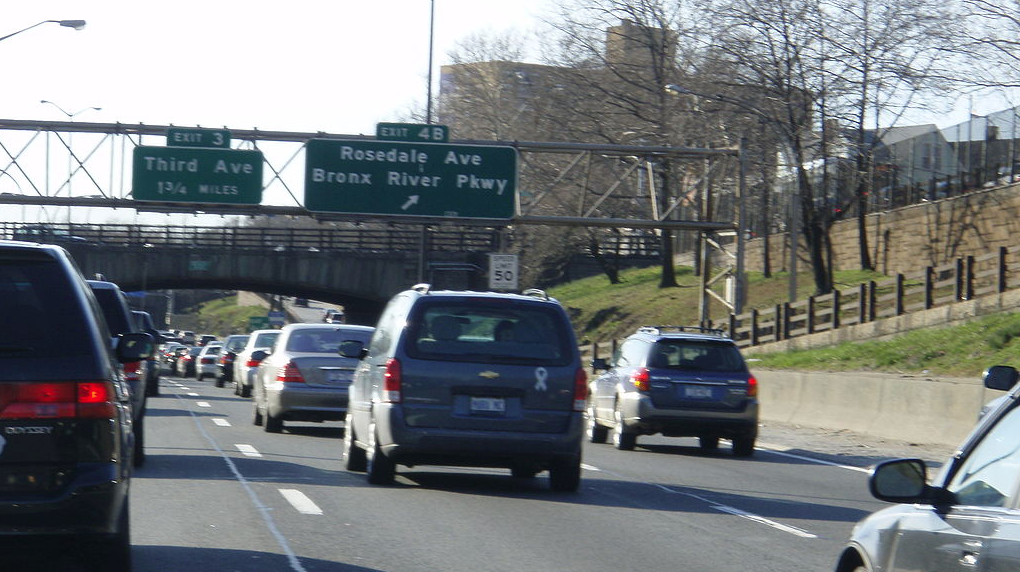Imagine there's no highway. It's easy if you try.
The city Department of Transportation has announced a big-time multi-agency effort to "re-imagine" the Cross Bronx Expressway, with the help of the state Department of Transportation, the city Planning Department and (wait for it) the city Department of Health and Mental Hygiene. The effort to possibly send the hated highway straight to hell will be funded by a grant from the U.S. Department of Transportation, which handed out plenty of cash to local communities to look at tearing down urban freeways in the Infrastructure Investment and Jobs Act of 2021.
The agencies claim that starting shortly after July 1, they'll be "embarking on a study to re-imagine the relationship between the Cross Bronx Expressway and its surrounding communities," according to the "Current Projects" page on the city DOT website. "The study will review past transportation and health studies and garner information from the community about priorities, needs, and future visions for the roadway, as well as recommendations to safely reconnect adjacent neighborhoods."
A description of the project on the Planning Department's website lists additional goals: Improve quality of life for residents, create new public open space, improve safety on local streets and along the corridor, more sustainably manage cross-Bronx traffic.
When the study is finished, the DOT is promising that by 2024, there will be both small- and large-scale proposals to deal with the highway (though the latter will likely involve capping, not eliminating, the highway).
Capping the Cross-Bronx, which runs from Throgs Neck to Highbridge, got national attention when the infrastructure bill passed in 2021, as Sen. Chuck Schumer and Reps. Jerry Nadler and Ritchie Torres highlighted the fact that "Reconnecting Communities" grants in the law could be used to start the process of doing something about the scar through the Bronx. The COVID-19 pandemic made the situation even more urgent, since the air pollution from traffic on the highway had already inflicted massive respiratory damage to residents of neighborhoods surrounding the highway, and those residents were then much more likely to have died of coronavirus as the pandemic raged through the city.
Finding a way to deal with the interstate highway was part of President Biden and Transportation Secretary Pete Buttigieg's stated commitment to fix urban development wrongs that resulted in things like highways moving 200,000 cars and trucks per day through residential neighborhoods, as the Cross-Bronx does now. Buttigieg toured cities where transportation planners put highways through Black neighborhoods in the mid-2oth century and talked about finding ways to reconnect the neighborhoods to larger city grids, but the price tag on projects to cap or tear down urban freeways is steep and doing so to the Cross-Bronx is no exception.
In 2018, before the the infrastructure bill passed, Columbia professor Peter Muennig suggested that capping the 2.4-mile portion of the interstate that runs in a below-grade cut through the borough, and building parks on the cap would cost about $757 million. The cost would be defrayed, Muennig said, by the fact that all of the 226,608 people living around the capped section of the highway would see "quality-adjusted life years, a combined measure of health and longevity" increase by two-months and a $1,629 per capita increase in their lives. Local Bronx activists have picked up the mantle on the idea to try to right a wrong wrought by Robert Moses and the larger planning profession in 1950s New York City, and find an environmental justice win for the Black and Latino communities who have dealt with noise and air pollution from the highway for decades.
Although the engagement and outreach on the study won't begin until later this year, the city's listed goals of creating new public open space and improving the quality of life along the highway corridor suggest that some form of capping the highway could be on the table.
Eliminating the highway entirely? That's most likely a figment of particularly optimistic imaginations.
To keep up on next steps of the study or to make your own suggestions for it, email CBX@planning.nyc.gov to stay in the loop about the city's next steps.






